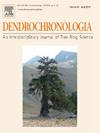关于落叶松/云杉木材鉴定问题的注释:从亚化石茎盘获得的树木年代学和木材解剖学见解
IF 2.7
3区 农林科学
Q1 FORESTRY
引用次数: 0
摘要
区分云杉(Picea sp.)和落叶松(Larix sp.)木材的问题已经存在了几十年,在木材鉴定中仍然存在争议。虽然已经提出了物种特异性解剖特征来解决这个问题,但它们的可变外观和有限的诊断能力阻碍了可靠的区分,特别是对于考古木材样本。在一个多世纪前从冰川冰碛沉积物中发现了一个茎盘,这让我们再次面临落叶松/云杉的识别问题。在这里,我们浏览了每个物种典型的木材解剖特征的文献,并在亚化石木盘中检查了这些特征。评估的主要特征包括心材和边材的颜色差异、早木材到晚木材的转变、径向壁管胞孔、射线管胞孔边界、每个树脂管上皮细胞的数量以及树脂管在射线中的位置。此外,我们测量了树木年轮的宽度,试图对磁盘进行树木年代学测定。树木年轮的测量使得精确的年代测定得以实现,并揭示了窄而轻的年轮的准十年发生,这表明了落叶松budmoth (Zeiraphera diniana Gn.)的周期性侵扰。基于这些特征的budmoth年轮的存在,以及与31个已发表和未发表的落叶松年轮的成功杂交,对比与云杉年轮的相关性较差,我们最终确定该盘为落叶松(Larix decidua Mill)。然而,我们的木材解剖观察并不能可靠地区分云杉和落叶松,这表明一些特征可能随着树龄和茎位而变化。这突出了需要进一步的研究,有针对性地采样活树,以验证某些解剖特征的诊断效用。本文章由计算机程序翻译,如有差异,请以英文原文为准。
Notes on the Larix/Picea wood identification problem: Dendrochronological and wood anatomical insights from a subfossil stem disk
The decades-old problem of distinguishing spruce (Picea sp.) from larch (Larix sp.) wood is still debated in wood identification. Although species-specific anatomical traits have been proposed to address this issue, their variable appearance and limited diagnostic power hinder reliable differentiation, particularly for archaeological wood samples. Finding a stem disk collected over a century ago from a glacial moraine deposit brought us to face the Larix/Picea identification problem again. Here, we skimmed the literature for wood anatomical features typical for each species and examined these traits in the subfossil wood disk. Key features assessed included heartwood and sapwood colour differences, earlywood-to-latewood transitions, tracheid pitting in radial walls, ray tracheid pit borders, the number of epithelial cells per resin canal, and the position of resin canals in rays. Additionally, we measured tree-ring widths to attempt dendrochronological dating of the disk. Tree-ring measurements enabled precise dating and revealed a quasi-decadal occurrence of narrow and light rings, indicative of cyclical larch budmoth (Zeiraphera diniana Gn.) infestations. Based on the presence of these characteristic budmoth rings and successful crossdating with 31 published and unpublished larch chronologies, compared to poor correlation with spruce chronologies, we conclusively identified the disk as Larix decidua Mill. However, our wood anatomical observations did not distinguish between spruce and larch reliably, suggesting that some features may vary with tree age and stem position. This highlights the need for further investigation with targeted sampling of living trees to validate the diagnostic utility of certain anatomical features.
求助全文
通过发布文献求助,成功后即可免费获取论文全文。
去求助
来源期刊

Dendrochronologia
FORESTRY-GEOGRAPHY, PHYSICAL
CiteScore
5.50
自引率
13.30%
发文量
82
审稿时长
22.8 weeks
期刊介绍:
Dendrochronologia is a peer-reviewed international scholarly journal that presents high-quality research related to growth rings of woody plants, i.e., trees and shrubs, and the application of tree-ring studies.
The areas covered by the journal include, but are not limited to:
Archaeology
Botany
Climatology
Ecology
Forestry
Geology
Hydrology
Original research articles, reviews, communications, technical notes and personal notes are considered for publication.
 求助内容:
求助内容: 应助结果提醒方式:
应助结果提醒方式:


